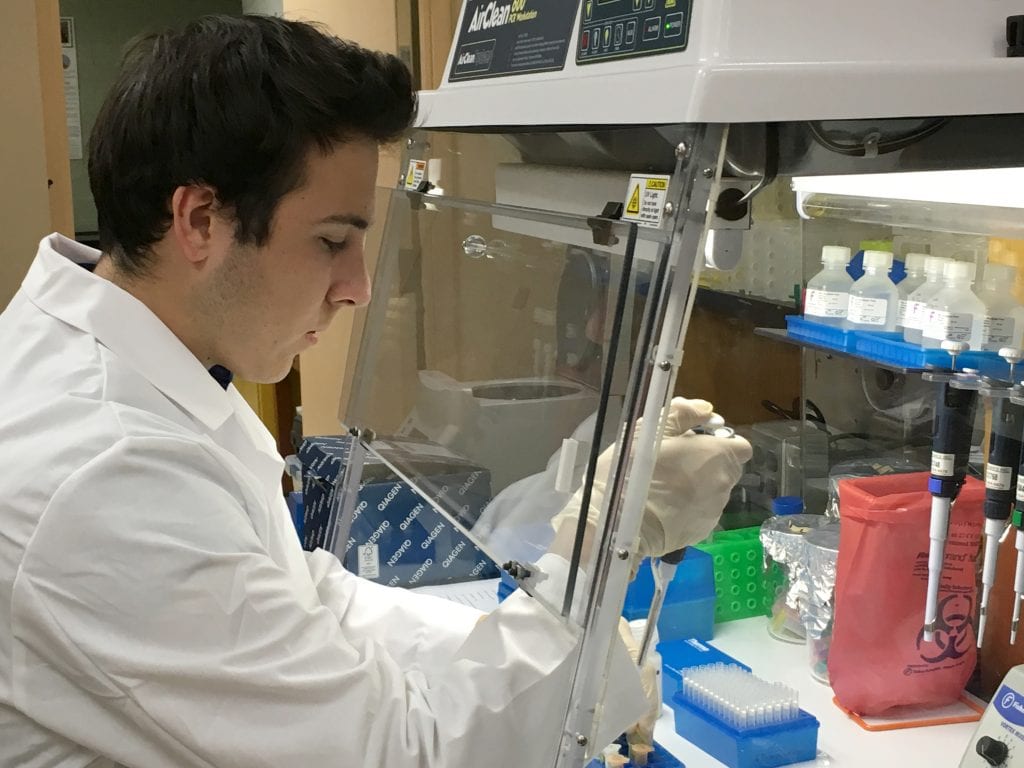 Pathology is a branch of medicine related to the study of diseases, pathogens, and their effects on the afflicted animals. Pathologists can play an important role in many aspects of animal health, including detecting infectious diseases in farm animals, revealing details about animal abuse cases, and elucidating the origin cell type of a tumor from a biopsy. Some pathologists investigate diseases in wildlife species, many of which are influenced in some manner by anthropogenic factors.
Pathology is a branch of medicine related to the study of diseases, pathogens, and their effects on the afflicted animals. Pathologists can play an important role in many aspects of animal health, including detecting infectious diseases in farm animals, revealing details about animal abuse cases, and elucidating the origin cell type of a tumor from a biopsy. Some pathologists investigate diseases in wildlife species, many of which are influenced in some manner by anthropogenic factors.
For the past few summers, I have worked as a research assistant for the Zoological Pathology Program, a research and diagnostic laboratory of the University of Illinois College of Veterinary Medicine. This laboratory mostly operates in conjunction with the Chicago Zoological Society’s Brookfield Zoo, Lincoln Park Zoo, John G. Shedd Aquarium, and the Forest Preserve District of Cook County. The Zoological Pathology Program also provides diagnostics for a large number of local, national, and international conservation organizations. The faculty of pathologists in this lab are world-renowned experts in their field and serve as lead pathologists for various Species Survival Plan (SSP) programs and conservation initiatives around the globe. I am interested in the key role that pathology can play in zoo management and wildlife conservation. You can imagine, then, that I was extremely grateful to have the opportunity to work in this lab.

Throughout the three summers during which I worked in this lab, I had a wide variety of responsibilities and experiences. This work involved cataloging their extensive collection of research samples, performing molecular biology research, and observing and assisting with necropsies.
I was involved in two major research projects through the Zoological Pathology Program. One of these projects involved parasitic agents that can infect passerine, or perching, bird species. Detection of this specific infectious agent can play a particularly important part in conservation efforts involving reintroduction of captive birds, specifically the Bali Mynah. Using a diagnostic tool developed by the lab, I worked on a project aimed at determining the shedding patterns of the pathogen. The results will allow us to determine the most efficient and effective protocol for diagnostic sampling.
The other major project was a collaborative study with the Shedd Aquarium’s Microbiome Project. We investigated the efficacy of various aquarium tank disinfection techniques on the maintenance and control of atypical Mycobacteria. Mycobacteria are common pathogens in aquatic systems and can cause fatal infections in fish. The goal of this research was to determine which disinfection techniques were better at decreasing overall loads of Mycobacterium sp. in the aquarium environment and if those disinfection techniques also altered levels of normal beneficial bacteria within these environments. These research projects not only improve our understanding the fundamental nature of these pathogens, they also can be used as a guide to inform animal care and prevent sometimes-devastating disease outbreaks in both captive and wild populations.
In addition to those two projects, I was given the opportunity to observe and assist with necropsies of both captive and wild animals. Necropsies are the animal equivalent of forensic autopsies in humans. Although some of these necropsies (particularly those of wildlife animals) involve investigating potential criminal activity, most of the necropsies performed for zoo and wildlife animals aim to uncover infectious or management-related disease. Zoo necropsies serve to help prevent the spread of infectious disease within a zoo population, and to inform management practices to ensure optimal animal health. Information we learn about zoo animals can also inform our understanding of disease in their wild counterparts. During my time with the Zoological Pathology Program, I participated in necropsies of various captive mammal, bird, reptile, fish, and amphibian species. I also assisted with necropsies involving long-term seasonal assessment of disease in wild fish and reptile species in various lakes and parks. This type of study can reveal geographical patterns of disease prevalence and can potentially uncover trends associated with anthropogenic changes to the local environment.
It is our duty as animal health professionals to better understand problems to which humans contribute and to minimize their effects on wild populations. I am extremely grateful for my experiences at the Zoological Pathology Program, and I am excited to pursue a career in anatomic pathology!
Carmen Smith is a current Cornell veterinary student (class of 2021) and Cornell undergraduate alumnus from the suburbs of Chicago. He plans to pursue a career in zoo and wildlife pathology. He is interested in wildlife and public health, and hopes to work at the intersection of disease and conservation.

